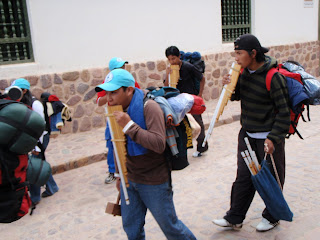If you are well you could answer, "muy bien!" or "very well!" Another phrase that asks how you are doing is, "como estas?" So, if someone gave you any of these greetings, "que tal?", "como anda" or "como esta", and you are well, you can say "muy bien!" Of course you might not be doing well. Then you might say "mal" (bad) or even "muy mal" (very bad). However, let´s hope your answer is always "bien, muy bien!"
As you know, Easter is coming in just a few days! There are many ways that Argentinians celebrate this holiday and some are very similar to our traditions in the United States. Some are very different, though, so I´d like to share with you the traditions I have learned about.
In Spanish Easter is called Las Pascuas. Here in Argentina the celebrations for Las Pascuas can last for two weeks. The first week begins on Palm Sunday, the Sunday before Easter, and is called semana santa, or week of the saints. This is the same as what we call Holy Week. We were in the city of Jujuy in northern Argentina on Palm Sunday and on just about every street we saw people selling small baskets woven from palm fronds and branches from olive trees. People hang these baskets in their doorways and fill them with the olive branches or flowers.
 Most people in Argentina are Roman Catholic and so on Palm Sunday and Easter Sunday they attend mass at their churches. In Jujuy there are several very old (over 400 years!) and lovely cathedrals. Here are some churchgoers leaving Palm Sunday mass at Catedral San Francisco carrying their palm baskets. Can you see the people selling the baskets on the street outside?
Most people in Argentina are Roman Catholic and so on Palm Sunday and Easter Sunday they attend mass at their churches. In Jujuy there are several very old (over 400 years!) and lovely cathedrals. Here are some churchgoers leaving Palm Sunday mass at Catedral San Francisco carrying their palm baskets. Can you see the people selling the baskets on the street outside? We saw another interesting tradition here in Humahuaca, where we are now. Groups of young people from various pueblos, or small towns, in this region form marching bands and travel around to the other pueblos with their instruments. They march around the main plazas and play for the townspeople who come out to watch. Drums and pan flutes, which are a traditional instrument of the Andes Mountains, are played. Each banda, or band, carries a banner with the name of their group and the name of a saint they are representing. These groups travel for a few days, camping out at night in the countryside, visiting many pueblos along the way.
We saw another interesting tradition here in Humahuaca, where we are now. Groups of young people from various pueblos, or small towns, in this region form marching bands and travel around to the other pueblos with their instruments. They march around the main plazas and play for the townspeople who come out to watch. Drums and pan flutes, which are a traditional instrument of the Andes Mountains, are played. Each banda, or band, carries a banner with the name of their group and the name of a saint they are representing. These groups travel for a few days, camping out at night in the countryside, visiting many pueblos along the way. 
 People celebrate the rebirth of Jesus Christ the whole week after Easter Sunday. They have parties, take vacations and, just like home, eat lots of sweets! A special bread called rosca is sold at all the panaderias, or bakeries, during the Easter holiday. It is a round loaf with a hole in the middle, like a large doughnut, and is decorated with dried fruits. Of course, chocolate is everywhere! Many stores have large window displays like this one filled with huge chocolate eggs and other kinds of candy.
People celebrate the rebirth of Jesus Christ the whole week after Easter Sunday. They have parties, take vacations and, just like home, eat lots of sweets! A special bread called rosca is sold at all the panaderias, or bakeries, during the Easter holiday. It is a round loaf with a hole in the middle, like a large doughnut, and is decorated with dried fruits. Of course, chocolate is everywhere! Many stores have large window displays like this one filled with huge chocolate eggs and other kinds of candy. Do you share any of these Easter traditions with the Argentinians? Do any of them seem very different to you? What is your favorite Easter tradition?
Do you share any of these Easter traditions with the Argentinians? Do any of them seem very different to you? What is your favorite Easter tradition?That´s all for now, so "chaio"! (This is pronounced chow, and is a way to say goodbye in Spanish
Hi Beth. Thanks for sharing that. I love the palm baskets and the flutes. Be safe.
ReplyDelete